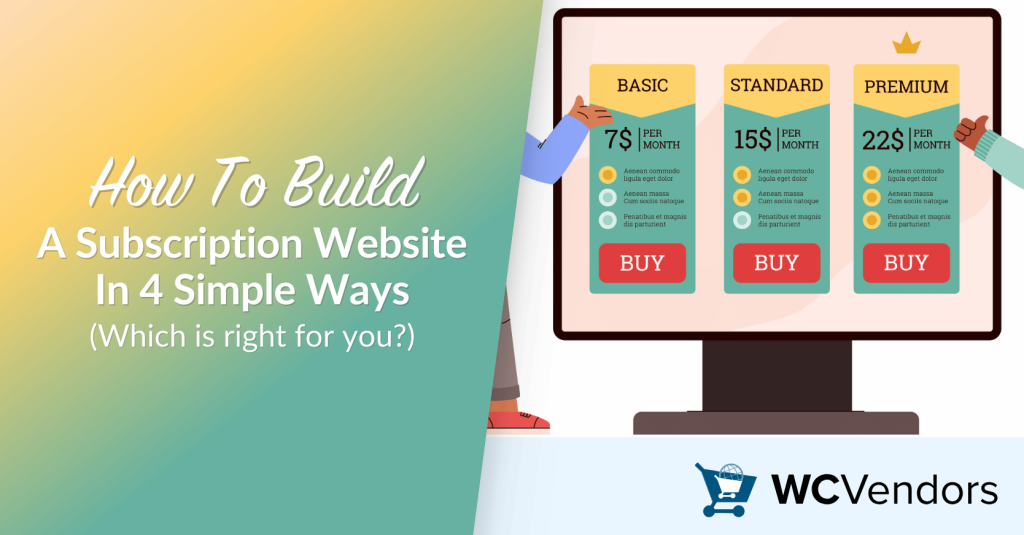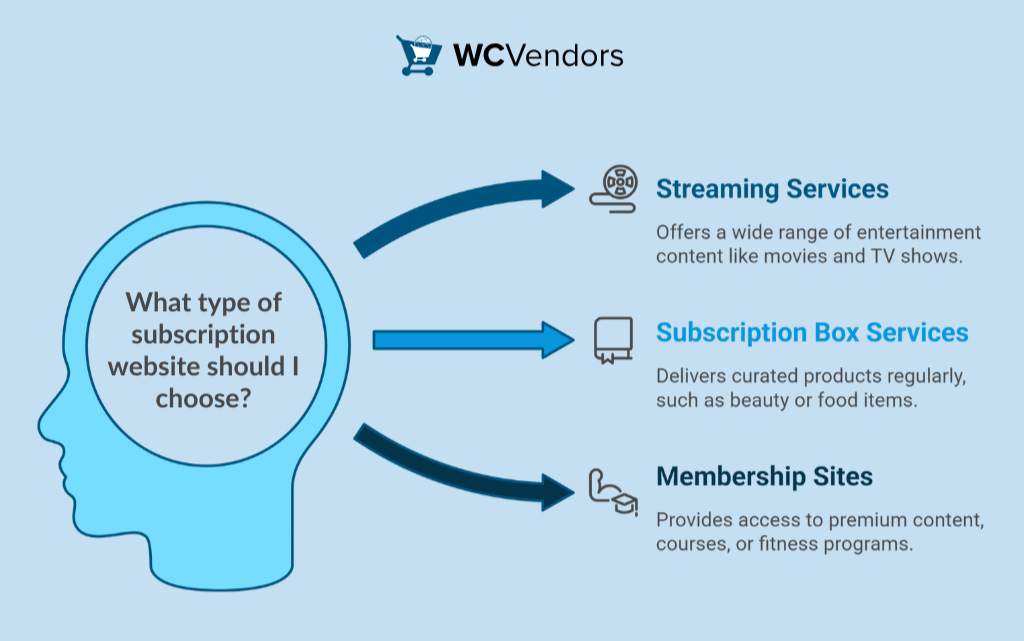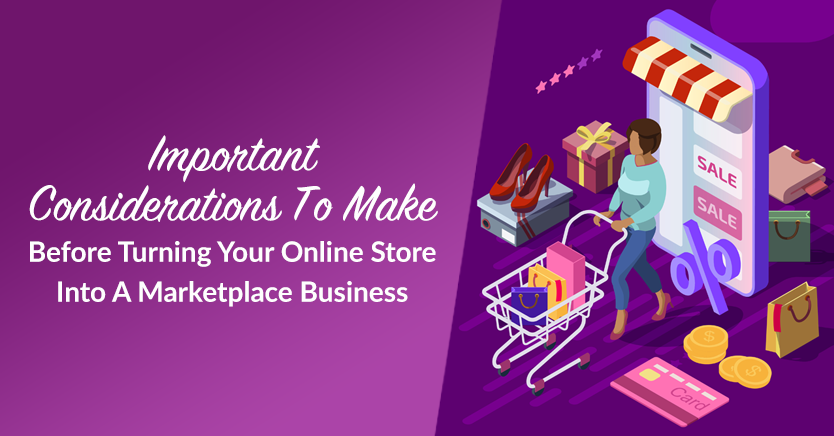
You want to build a subscription website, but where do you start? For many marketplace owners, launching a subscription site feels overwhelming. Maybe you’re worried about the technical setup, how to manage subscriptions, or finding the best way to deliver value to your members.
The good news? Building a subscription website doesn’t have to be complicated.
With the right tools and strategies, you can build a profitable subscription model that will attract customers and generate recurring revenue. This article will show you four simple ways to build a subscription website.
So, let’s get started!
What Is A Subscription Website?
A subscription website is a type of membership website where users pay recurring fees (monthly, annually, or on another schedule) to access exclusive content, products, or services. These websites use a subscription model. They offer value to customers and generate steady revenue for the owner.

Examples of subscription websites include:
- Streaming services like Netflix or Disney+
- Subscription box businesses for products like beauty supplies or food
- Membership sites offering premium content, online courses, or fitness programs
By creating a subscription website, you can build long-term relationships with your customers. At the same time, you ensure a steady and predictable income stream.
Let’s explore four practical ways to do it!
1. Build A Subscription Website On A Multi-Vendor Marketplace
Most people don’t think of using a multi-vendor marketplace to build their subscription website. In fact, many might not even be familiar with what a multi-vendor marketplace is. Simply put, it’s a platform where multiple vendors can sell their products or services to customers—all under one roof. Think of it as a shopping mall, but online!
If you’re a store owner considering subscription options, you might need to connect with a multi-vendor marketplace owner first. They can provide the platform you need to set up your subscription-based offerings.
Alternatively, you can take it one step further—start building your own multi-vendor marketplace! Doing so will create an ecosystem where vendors and customers meet. It will also scale your subscription-based business.
WC Vendors: Your Perfect Starting Point

To begin, you’ll need to build your multi-vendor marketplace using WC Vendors on WordPress and WooCommerce. This powerful combination provides a solid foundation for creating a subscription-based website. Once your marketplace is ready, you can enhance its functionality with WC Vendors WooCommerce Subscriptions.
This plugin is perfect for businesses focused on subscription-based products, such as:
- Monthly delivery services for specialty goods (e.g., coffee, snacks, or beauty products)
- Membership plans for exclusive content or digital downloads
- Access to ongoing professional services, such as consultations or coaching sessions
With WC Vendors WooCommerce Subscriptions, you can:
- Build a membership website with flexible subscription plans (e.g., monthly, yearly, or custom intervals).
- Automate recurring payments with multiple payment gateways.
- Offer free trials, sign-up fees, and exclusive subscription options.
- Enable vendors to manage subscriptions independently and track performance with detailed reports.
- Customize notifications for renewals and updates to keep vendors and customers informed.
A New Perspective
Creating a multi-vendor marketplace might not have been your initial plan. However, it’s an exciting way to scale your subscription business. Think about the possibilities. You could host a thriving platform where multiple vendors attract a steady stream of customers. At the same time, you generate recurring revenue.
Doesn’t that sound like a win-win?
If you’re still in the decision-making phase,
why not explore this option? Check out
this article to help you decide:
Important Considerations To Make
Before Turning Your Online Store
Into A Marketplace Business
For those looking for faster and more cost-effective options, there are other ways to get started. Let’s explore them next!
2. Build From Scratch Using Custom Development

Building your subscription website from scratch gives you total freedom. With the help of a developer or development team, you can design a fully customized membership website. Additionally, it can be tailored specifically to your business needs.
This method is ideal for businesses with unique requirements or advanced features. It works best when ready-made tools or subscription plugins can’t meet your needs. For example, if you need complex integrations, specialized user roles, or a fully bespoke user experience, custom development is the way to go.
However, there are pros and cons to consider.
Pros:
- Unlimited customization: You’re not restricted by the limitations of plugins or prebuilt tools.
- Scalable solutions: Your site can grow and evolve with your business.
- Tailored experience: Every detail can be optimized to meet your audience’s needs.
Cons:
- High costs: Custom development can be expensive, especially for complex features.
- Time-intensive: Building a website from scratch requires time for design, development, and testing.
- Ongoing website management: You’ll need technical expertise or a developer to handle updates and issues.
If your business needs a truly unique subscription model, this may be the best route. But remember, it’s a commitment.
3. Use A Website Builder With Subscription Features

Using a membership website builder is one of the easiest ways to get started. Platforms like Wix and Squarespace provide intuitive drag-and-drop tools. As a result, they allow you to create a membership website quickly, even without technical experience.
These website builders include basic features for managing paid member subscriptions. For example, they often offer gated content, subscription plans, and payment integration. While this method is user-friendly, it has limitations in customization and scalability.
Pros:
- User-friendly interface: Drag-and-drop tools make it easy for beginners to design a site.
- Quick setup: You can launch your membership website in a short time.
- Cost-effective options: A free membership website builder is perfect for testing the waters.
Cons:
- Limited customization: Builders often lack the flexibility to create advanced or unique features.
- Scalability challenges: As your business grows, you may outgrow the platform’s capabilities.
- Platform dependency: You’ll rely on the builder for hosting, updates, and technical support.
For small businesses or those just starting out, a free membership website builder can be a practical choice. But as your business evolves, you might need more advanced tools for greater flexibility.
Curious about the last option? Let’s dive into the next method!
4. Build A Subscription Website On A SaaS Subscription Platform

If you want a plug-and-play solution, SaaS (Software-as-a-Service) platforms like Kajabi, Patreon, or Substack are designed for subscription businesses. These platforms are perfect for content creators, online coaches, or businesses offering subscription services.
SaaS platforms handle most of the technical work, from hosting and payment processing to user management. This makes them perfect for beginners or anyone who wants to launch quickly without dealing with coding or plugins.
But before you decide, let’s consider the pros and cons.
Pros:
- Quick and easy setup: You can get your subscription site running in no time.
- No technical expertise needed: The platform takes care of hosting, payments, and user management.
- All-in-one solution: Everything you need is included in one platform.
Cons:
- Higher transaction fees: SaaS platforms often take a percentage of your earnings.
- Limited branding options: Customizing the look and feel of your site may be restricted.
- Less control: You’ll have less flexibility over your subscription business model.
If speed and simplicity are your top priorities, a SaaS subscription platform can be a great fit.
Final Thoughts
Building a subscription website opens doors to long-term customer relationships and recurring revenue. With the right tools, you can create a site that not only serves your audience but also scales with your business.
To recap, here’s what you need to remember as you explore how to build a subscription website:
- What Is a Subscription Website?
- Create It on a Multi-Vendor Marketplace
- Build from Scratch Using Custom Development
- Use a Website Builder with Subscription Features
- Use a SaaS Subscription Platform
By considering these methods, you can choose the approach that best aligns with your business goals. If you’re looking for a simple and scalable solution, consider creating a multi-vendor marketplace with WC Vendors. It’s an excellent choice for growing your subscription business.
Do you have any questions about how to build a subscription website? Share your thoughts in the comments below! We’d love to hear from you.

